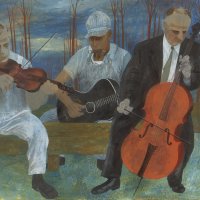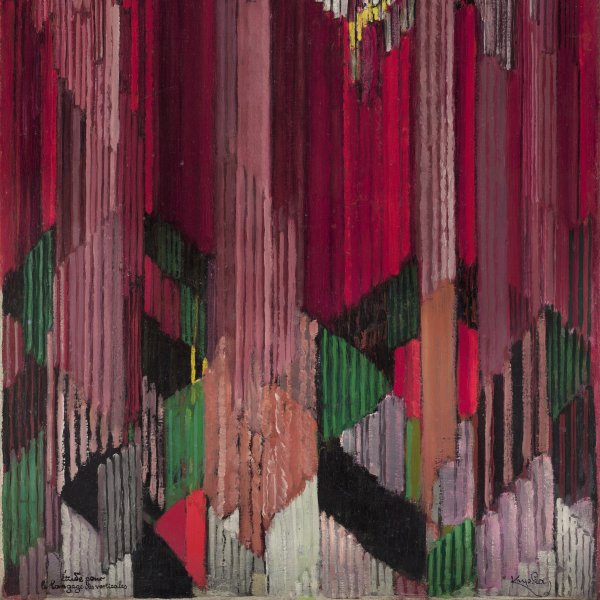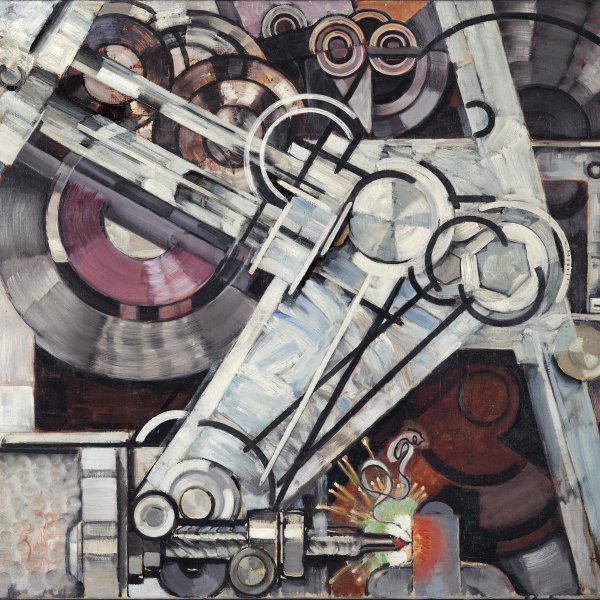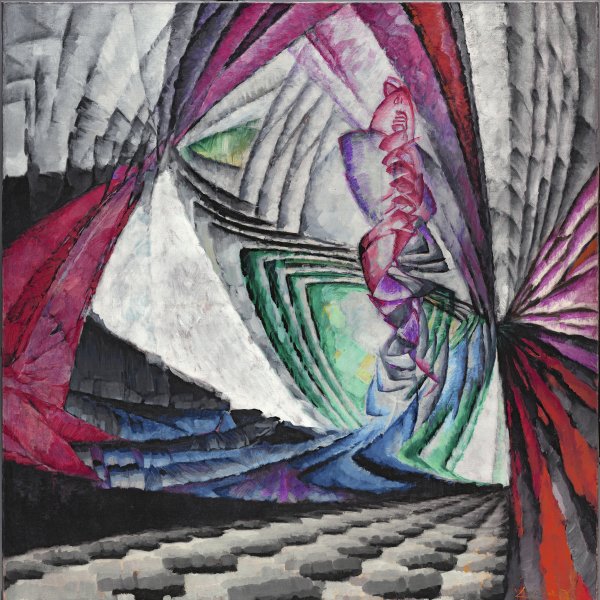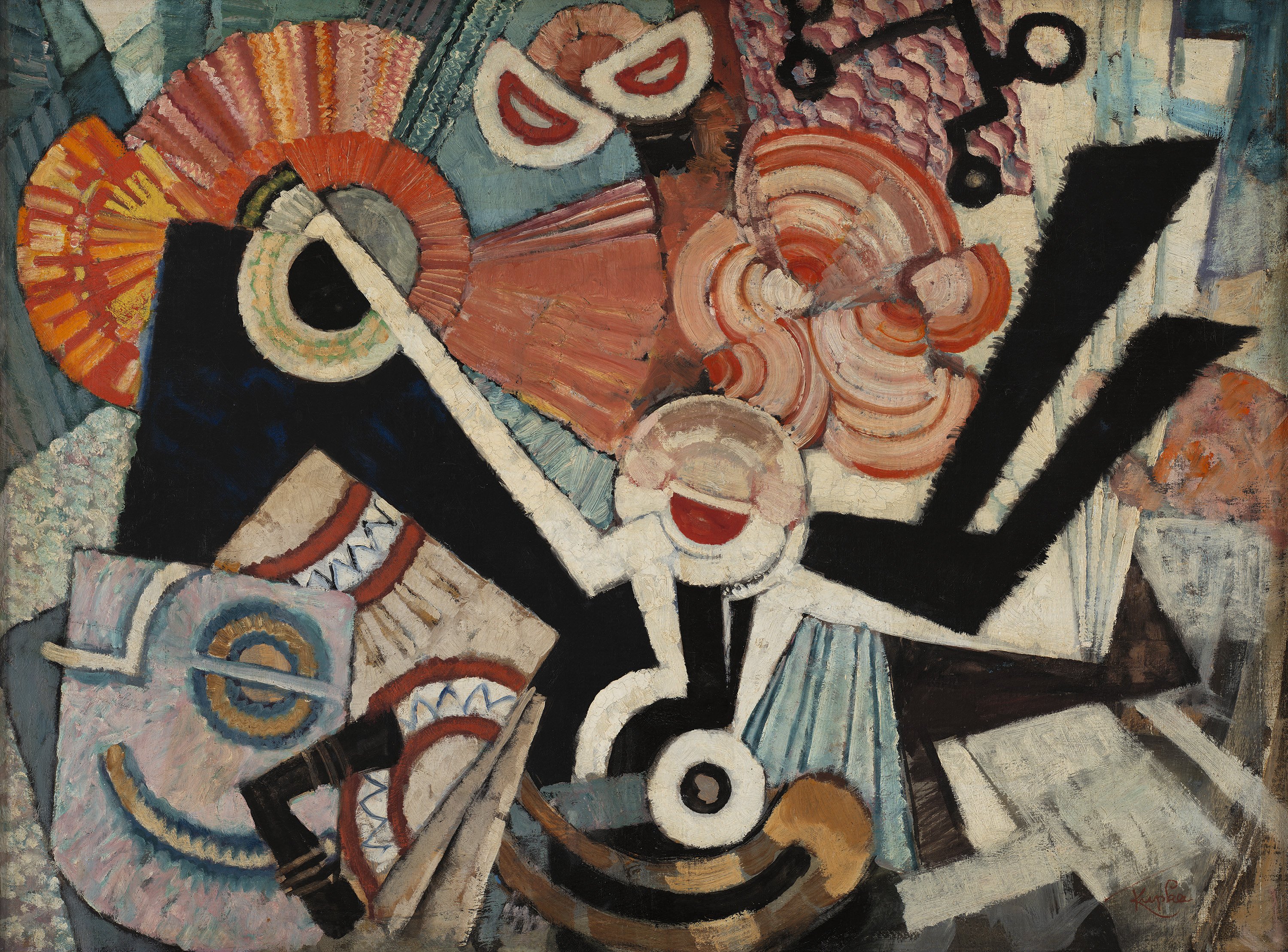Syncopated Accompaniment (staccato)
ca. 1928 - 1930
Oil on canvas.
73 x 100.4 cm
Carmen Thyssen Collection
Inv. no. (
CTB.1996.44
)
Room I
Level 0
Carmen Thyssen Collection and Temporary exhibition rooms
Kupka's reputation as an avant-gardist was made in Paris before 1914 with paintings that were taken to be entirely non-objective, most controversial of all two ambitious canvases shown at the Salon d'Automne in 1912, to which he gave titles evocative of music: Amorpha, Fugue in Two Colours and Amorpha, Warm Chromatics. A Czech living at Puteaux on the fringes of Paris, his early career had been in Vienna. He was a naturist, a practising spiritualist, a dabbler both in science and in Theosophy (a pan-European movement aimed at reconciling Western and Eastern religious beliefs). And, between 1918 and 1924, he was one of the few artists based in France who consistently painted and exhibited non-objective work. Indeed, until 1924, his profile as a non-objective painter in France was certainly higher than that of Piet Mondrian, and in the early twenties he was able to attract two faithful French followers in Antoine-Pierre Gallien and the Lille-based Félix Del Marle. Critical and commercial success, however, did not materialise from his regular showings at the Salon des Indépendants and his two exhibitions, at the Galerie Pvolozky (1921), and at the Galerie La Boétie (1924), at the latter of which he was represented by over one hundred works. In 1925 he kept aloof from the exhibition L'Art d'Aujourd'hui, the first organised attempt in Paris to promote non-objective art as the art of the future. Fabre has suggested that this was because Y. V. Poznanski, who put the exhibition together, was a protegé of Albert Gleizes; it was Gleizes above all who, Kupka felt, threatened his place at the head of Parisian non-objective painting. It is likely that the disappointments of the early 1920s lay behind his decision later in the decade to return to representation, with the series of machine pictures which Vachtová has called the "Machine Cycle". Despite its high degree of abstraction, Syncopated Backing is from this series.
Kupka himself had doubts about the works from this series, worrying about the degree of their dependence on the direct observation of machinery. They are usually considered evidence not merely of a decision to change direction but of a profound loss of confidence. They were not exhibited at the time, and indeed the artist systematically excluded them from the retrospectives held in Paris of 1936 and 1946. None were shown publicly before Kupka's death in 1957. Since they were left undated too, dependable data from which to establish an exact chronology does not exist. When this picture was sold at Christie's in 1996, it was given the date 1930 and the title La petite méchanique, no evidence being presented for the latter. In fact, it is a smaller variant of the oil Syncopated Backing No. 1 (known also as Staccato Rhythm), which was included in the gift of Kupka's widow to the French State in 1957, and which was shown the following year in the retrospective of the artists at the Musée national d'art moderne. I have therefore given it the same title. The larger work has traditionally been dated 1928.
The Christie's dating of the present picture to 1930 was justified by its "more abstract character" in comparison to such canvases from the "Machine Cycle" as Machine Drill, now at Madrid, Museo Thyssen-Bornemisza. Certainly its stark contrasts between black and white shaft-like elements and segmented disks in brilliant reds, oranges and blues have a pictorial immediacy at odds with the shimmering illusionist effects of metal machine parts spinning at speed in Machine Drill. And certainly, the paint is more summarily applied, achieving a far more tactile, material presence, though this is less the case in the larger Parisian variant. Bearing in mind, as the author of the Christie's entry clearly has, Vachtová's convincing argument that there is a development in the "Machine Cycle" away from dependence on observed machine elements towards more highly abstracted images, this does indeed support a later dating than works like Machine Drill. I have dated Machine Drill, c. 1927-1929, and so suggest here an equally approximate, slightly later dating of c. 1928-1930 for Syncopated Backing.
1929-30 saw the beginning of the restoration of Kupka's confidence as a non-objective painter; it followed from his involvement with Theo van Doesburg, founder of the De Stijl magazine and movement. In 1930, he took part in discussions with Van Doesburg which would lead to the foundation of the exhibiting group Abstraction-Création in June 1931, a few months after the Dutchman's death. In this new broad alliance of "abstract" and "non-objective" artists, Kupka's status was assured again for several years to come: he was suddenly, with Mondrian and Van Doesburg, an important figure from the origins of "abstract art". One indication of a later date for Syncopated Backing, is its sheer élan-it is difficult to connect so positive and uncompromising a statement with lack of confidence-and its title confirms Kupka's commitment to a move once again broadly in tune with his pre-1914 experiments as a non-objective painter. The title no longer makes a literal reference to machinery. Instead, the reference is to music: not to fugues or chromatics, as with the Amorpha paintings in 1912, but to jazz.
From the last years of the 1914-1918 war, jazz had swept into Europe from the USA, picking up among its millions of enthusiasts Fernand Léger as well as Mondrian. Here Kupka reveals himself open to its energy, and open also to the analogy often drawn (among others by Léger) between the jarring rhythms of machine motion and the syncopations of jazz. Indeed, this painting and the larger Parisian variant on this theme are more obviously to be compared with Léger's Disks of 1918 than they are with Kupka's own Amorpha paintings. Léger too based a particularly forceful brand of abstraction on mechanical elements. For him too, jazz and the mechanical syncopation of piston-shafts and cog-wheels in movement went together, and both found equivalence in the pictorial force of his Disks. Kupka's experiments with abstraction and the end of the 1920s were not, ultimately, a backward-looking return to pre-First World War preoccupations. They were, as his more fully non-objective work of the 1930s would be, new moves in a new, inter-war context. The energetic abstraction of Syncopated Backing, with its mechanistic piston-and-cog forms, anticipates Kupka's mid-1930s series Jazz-Hot.
Christopher Green
Kupka himself had doubts about the works from this series, worrying about the degree of their dependence on the direct observation of machinery. They are usually considered evidence not merely of a decision to change direction but of a profound loss of confidence. They were not exhibited at the time, and indeed the artist systematically excluded them from the retrospectives held in Paris of 1936 and 1946. None were shown publicly before Kupka's death in 1957. Since they were left undated too, dependable data from which to establish an exact chronology does not exist. When this picture was sold at Christie's in 1996, it was given the date 1930 and the title La petite méchanique, no evidence being presented for the latter. In fact, it is a smaller variant of the oil Syncopated Backing No. 1 (known also as Staccato Rhythm), which was included in the gift of Kupka's widow to the French State in 1957, and which was shown the following year in the retrospective of the artists at the Musée national d'art moderne. I have therefore given it the same title. The larger work has traditionally been dated 1928.
The Christie's dating of the present picture to 1930 was justified by its "more abstract character" in comparison to such canvases from the "Machine Cycle" as Machine Drill, now at Madrid, Museo Thyssen-Bornemisza. Certainly its stark contrasts between black and white shaft-like elements and segmented disks in brilliant reds, oranges and blues have a pictorial immediacy at odds with the shimmering illusionist effects of metal machine parts spinning at speed in Machine Drill. And certainly, the paint is more summarily applied, achieving a far more tactile, material presence, though this is less the case in the larger Parisian variant. Bearing in mind, as the author of the Christie's entry clearly has, Vachtová's convincing argument that there is a development in the "Machine Cycle" away from dependence on observed machine elements towards more highly abstracted images, this does indeed support a later dating than works like Machine Drill. I have dated Machine Drill, c. 1927-1929, and so suggest here an equally approximate, slightly later dating of c. 1928-1930 for Syncopated Backing.
1929-30 saw the beginning of the restoration of Kupka's confidence as a non-objective painter; it followed from his involvement with Theo van Doesburg, founder of the De Stijl magazine and movement. In 1930, he took part in discussions with Van Doesburg which would lead to the foundation of the exhibiting group Abstraction-Création in June 1931, a few months after the Dutchman's death. In this new broad alliance of "abstract" and "non-objective" artists, Kupka's status was assured again for several years to come: he was suddenly, with Mondrian and Van Doesburg, an important figure from the origins of "abstract art". One indication of a later date for Syncopated Backing, is its sheer élan-it is difficult to connect so positive and uncompromising a statement with lack of confidence-and its title confirms Kupka's commitment to a move once again broadly in tune with his pre-1914 experiments as a non-objective painter. The title no longer makes a literal reference to machinery. Instead, the reference is to music: not to fugues or chromatics, as with the Amorpha paintings in 1912, but to jazz.
From the last years of the 1914-1918 war, jazz had swept into Europe from the USA, picking up among its millions of enthusiasts Fernand Léger as well as Mondrian. Here Kupka reveals himself open to its energy, and open also to the analogy often drawn (among others by Léger) between the jarring rhythms of machine motion and the syncopations of jazz. Indeed, this painting and the larger Parisian variant on this theme are more obviously to be compared with Léger's Disks of 1918 than they are with Kupka's own Amorpha paintings. Léger too based a particularly forceful brand of abstraction on mechanical elements. For him too, jazz and the mechanical syncopation of piston-shafts and cog-wheels in movement went together, and both found equivalence in the pictorial force of his Disks. Kupka's experiments with abstraction and the end of the 1920s were not, ultimately, a backward-looking return to pre-First World War preoccupations. They were, as his more fully non-objective work of the 1930s would be, new moves in a new, inter-war context. The energetic abstraction of Syncopated Backing, with its mechanistic piston-and-cog forms, anticipates Kupka's mid-1930s series Jazz-Hot.
Christopher Green

